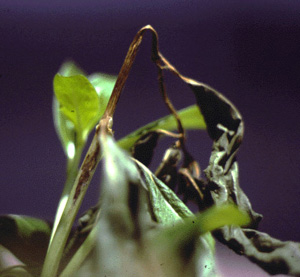
Click on image to view larger.
|
Crown and Root Rot
(Phytophthora spp.)
Most susceptible plants:
gerbera daisy, gloxinia, pansy
This disease is second only to Impatiens Necrotic Spot virus as a serious pathogen in gloxinia. Root and crown rot can also cause serious losses in gerbera daisy production. Infection can occur at any stage of gerbera production but seems to be more common after flowering begins.
Symptoms:
Plants fail to grow adequately and usually remain noticeably stunted. The foliage develops an obvious off-color. Petioles may become infected where they attach in the crown area; as the petiole collapses, the attached leaf dies also. As the disease progresses, the entire plant wilts and dies. Phytophthora root and crown rot more commonly results in a rapid plant wilt, in which the plants appear normal and healthy one day but develop symptoms of rapid wilt and decline. The pattern in the flat or on the greenhouse bench is usually random but can be extensive, involving a large number of plants, especially if plants are not grown on benches. Overhead watering readily splashes the pathogen from plant-to-plant. Examination of the symptomatic plant will usually reveal a very wet root ball with significant root and crown discoloration and deterioration.
Control:
Avoid growing plants on the ground or on mesh on the ground. Make sure that transplants are not planted too deeply: at the approximate same depth as the original plug not below the crown area. Avoid compaction of the rooting medium. Irrigate carefully; avoid overwatering. Drench-applied fungicides can be effective in managing this disease but should not be relied on to overcome poor cultural conditions.
|